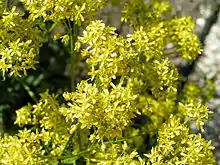Woad
Woad is a flowering plant that was cultivated to produce indigo dye. It is native to the Mediterranean, Central Asia, and Europe. It was historically produced in England, France, and Germany in medieval times. Eventually, the Indigo plant replaced woad as Europe's main cash crop that produces indigo dye.[1] Woad also has medicinal properties, as an astringent. Romans referred to Celts of northern Britain as Picts because they used woad to heal their battle scars, producing a blue tattoo.[1][2]
| Woad | |
|---|---|
 | |
| Woad flowers | |
| Scientific classification | |
| Kingdom: | Plantae |
| Clade: | Tracheophytes |
| Clade: | Angiosperms |
| Clade: | Eudicots |
| Clade: | Rosids |
| Order: | Brassicales |
| Family: | Brassicaceae |
| Genus: | Isatis |
| Species: | I. tinctoria |
| Binomial name | |
| Isatis tinctoria | |
| Synonyms | |
| |
References
Wikimedia Commons has media related to Isatis tinctoria.
Wikispecies has information on: Isatis tinctoria.
- Speranza, Jasmine; Miceli, Natalizia; Taviano, Maria Fernanda; Ragusa, Salvatore; Kwiecień, Inga; Szopa, Agnieszka; Ekiert, Halina (2020-03-01). "Isatis tinctoria L. (Woad): A Review of Its Botany, Ethnobotanical Uses, Phytochemistry, Biological Activities, and Biotechnological Studies". Plants. 9 (3): 298. doi:10.3390/plants9030298. ISSN 2223-7747. PMC 7154893. PMID 32121532.
- Carr, Gillian. "Woad, tattooing, and identity in later Iron Age and early Roman Britain".
This article is issued from Wikipedia. The text is licensed under Creative Commons - Attribution - Sharealike. Additional terms may apply for the media files.